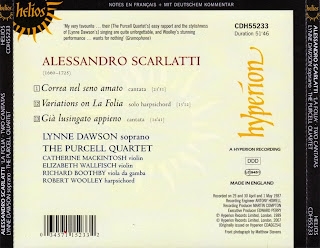"Piet Van Bockstal plays with staggering virtuosity and an almost terrifying conviction; he gets excellent support from Brabbins and the Lahti Symphony and from pianist Yutaka Oya. BIS�s engineers capture it all with their usual skill (on the 5.0 tracks, the sound is nearly palpable), and the notes, mainly by Aho himself, give just the information you need. In sum, strongly recommended." --FANFARE
�There�s a chamber-like intensity to this concerto � a heightened instrumental clarity if you will � and oboist Piet Van Bockstal is a gentle and evocative soloist throughout...Fine music and musicianship, faithfully caught; what BIS does best.� --MusicWeb International, May 2013

All three of these works rely on extended oboe techniques�but each does so in a different way. In the Sonata (1984-5, by far the Read more Solo IX (2010), traces of the normal/extended conflict remain in the form of sometimes bitter conversation (even confrontation) among differing �sound worlds,� but without the morally loaded overlay (pure/impure) that we find in the sonata. In the Concerto (2007)�which borrows liberally from Arabic music in its scales, rhythms, and instrumentation�the extended techniques have been integrated into the soloist�s voice. No longer reflecting a musical �other,� they are treasured for their expressive potential.
Aho is one of the most distinguished of our living composers; and, on the basis of what I�ve heard (his output is enormous), one of the most consistent: He�s stylistically wide-ranging, but his concentration is unfailing. It�s perhaps no surprise, then, that all three of these imaginative works hold your attention from first note to last. Or, more accurately, these works reward your attention from first note to last. They�re not easy listening�they won�t carry you along without effort on your part. The sonata, which makes some apparent allusions to the Shostakovich 10th, is especially challenging, as both the emotional content of the music and the relation of the two performers are apt to shift unexpectedly and sometimes violently, leaving you in a state of anxious vulnerability. There�s a bit less whiplash in the 10-minute solo work, but this, too, is both vehement and changeable in a way that keeps you on your guard.
That said, it�s the concerto to which I find myself returning most often, perhaps because it makes the most of Aho�s exceptional timbral imagination. Gavin Dixon recently referred to the �Nordic chill� of Aho�s Clarinet Quintet ( Fanfare 36:3), but there�s no chill in this Middle-Eastern inflected music. There�s no musical tourism, either�no attempt at tickling us with exoticism of the sort we hear in Ibert�s Escales , the Corigliano Oboe Concerto, or the �Arab Village� from Schuller�s Seven Studies on Themes of Paul Klee . In part, that�s because the Arabic elements are fundamental to his expressive palette, rather than a superficial add-on. Even more, though, it�s because the intensity of the music�dedicated to the memory of Aho�s mother, who died just as he was finishing it�is so far from the postcard aesthetic. The work begins with a 10-minute lament. That�s followed by four more movements, played without pause. They range wildly in character, yet the sense that the soloist is railing against the pain of the world remains. The struggle is sometimes beneath the surface of the music, but it�s never far away, and it erupts with particular violence at the end of the fifth movement. In the end, the concerto leaves you drained�and I wish that BIS had placed it at the end of the disc rather than at the beginning.
Piet Van Bockstal plays with staggering virtuosity and an almost terrifying conviction; he gets excellent support from Brabbins and the Lahti Symphony and from pianist Yutaka Oya. BIS�s engineers capture it all with their usual skill (on the 5.0 tracks, the sound is nearly palpable), and the notes, mainly by Aho himself, give just the information you need. In sum, strongly recommended.
FANFARE: Peter J. Rabinowitz
 Following the recent release of their recording of Brahms�s Ein deutsches Requiem, Sir Simon Rattle and the Berliner Philharmoniker turn their attention to another great 19th-century German work, Anton Bruckner�s Symphony No. 4. The recording, taken in concert, is scheduled for release in May 2007 to commemorate the 125th anniversary of the Berliner Philharmoniker, which was founded in May of 1882.
Following the recent release of their recording of Brahms�s Ein deutsches Requiem, Sir Simon Rattle and the Berliner Philharmoniker turn their attention to another great 19th-century German work, Anton Bruckner�s Symphony No. 4. The recording, taken in concert, is scheduled for release in May 2007 to commemorate the 125th anniversary of the Berliner Philharmoniker, which was founded in May of 1882.















































